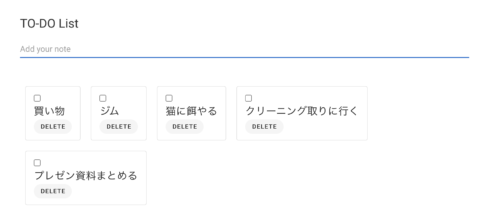いつもお世話になっております。
最近アトミックデザインなるものを覚えたのですが、具体的な使い方がピン…!と来ていませんでした。
componentsをatomsやorganismsに分けるのはわかるんですけどmoleculesって一体どんなもんに使うのよ?ってなもんでした。
ところがtodoリストでリストしたアイテムのdeleteボタンを$emitで実装する過程で、なるほど!と膝を叩いたので備忘録的に残しておきたいと思います。

このアイテム1つ1つに入っているDELETEボタンです。
親であるtodo.vueはこんな感じ。UIはVuetifyを使っています。
<v-card
v-for="(todo, index) in todos"
:key="index"
max-width="344"
outlined
style="margin: 10px"
>
<v-list-item>
<v-list-item-content style="display: block">
<input v-model="todo.isDone" type="checkbox" />
<v-list-item-title
class="text-h6 mb-1 item-title"
:class="{ done: todo.isDone }"
>
{{ todo.item }}
</v-list-item-title>
<DeleteBtn @deleteTodo="deleteItem(index)" />
</v-list-item-content>
</v-list-item>
</v-card>この後DeleteBtnで<v-btn>作って$emitしてもよかったのですが、既に<Button>コンポーネントは作成済みでした。
<template>
<v-btn
:color="color"
:class="classValue"
:tile="tile"
:disabled="disabled"
:text="text"
:outlined="outlined"
:block="block"
:elevation="elevation"
:small="small"
:rounded="rounded"
@click="click"
>
<slot></slot>
</v-btn>
</template>
<script>
export default {
props: {
click: {
type: Function,
required: true,
},
color: {
type: String,
default: '',
},
classValue: {
type: String,
default: '',
},
tile: {
type: Boolean,
default: false,
},
disabled: {
type: Boolean,
default: false,
},
text: {
type: Boolean,
default: false,
},
outlined: {
type: Boolean,
default: false,
},
block: {
type: Boolean,
default: false,
},
elevation: {
type: String,
default: '0',
},
small: {
type: Boolean,
default: true,
},
rounded: {
type: Boolean,
default: true,
},
},
}
</script><template>
<div>
<Button :click="itemDelete">DELETE</Button>
</div>
</template>
<script>
export default {
methods: {
itemDelete() {
this.$emit('deleteTodo')
},
},
}
</script>![[Nuxt.js]componentsのButtonを使ってDeleteボタンDeleteBtnを実装](https://nolyc.net/wp-content/uploads/2021/06/スクリーンショット-2021-06-29-15.19.25.png)

